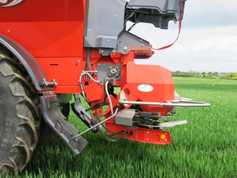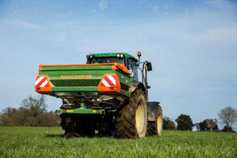David and Tory Baker, Birr, Co Offaly
We started on the road to expansion in 1985, so we have grown throughout the quota era. For us, sourcing milk quota was just one part of the expansion process, along with sourcing good land blocks, quality stock and building relationships with landowners, banks and staff. Today, we own 450 cows and rent over 220ha on a long-term lease.
We have met with many challenges along the way, of which some were bureaucratic, relating to milk quota and the transfer of this quota to different processors when we moved farms. Happily, this process will not have to be repeated in the future.
Developing farm infrastructure, particularly on rented farms, was a major cost. This was financed through cashflow and borrowings. Ensuring a good record with the bank was an essential part of securing finance, particularly for us, as we do not have any land to be used as collateral. Monthly cashflow budgets are now as routine as doing a grass walk or milk sampling.
As the herd grew, so too did the labour requirement, and over the years we have been fortunate to have many great people come and work for us. We have found that as the farm got bigger, we spent more and more time working with people as opposed to working with stock, which in itself brings challenges. We have had to learn about rostering, employment legislation and human resource management, and all of this takes time – about 20 hours a week is now spent in the office administering the business.
One of the biggest learning experiences for us has been the challenge of managing a large herd. While the fundamentals are the same regardless of herd size, it is definitely harder to maintain body condition score at the shoulders of the year, when cows are walking long distances to the faraway paddocks. The quality of roadways is also important and we find that we are constantly spending money improving and upgrading roads.
In terms of what we would do differently if starting out again, I’d say sourcing good stock is definitely essential, and ideally from within your own herd. While you would have to pay more for better-quality stock, we feel that this is money well spent. Secondly, farm infrastructure should be scaled to the number of cows you plan to milk from day one. We have found that we have had to increase the size of water troughs, water pipes and the width of farm roadways as cow numbers have increased, and it would have been cheaper if they were the correct size from day one.
We are both very positive about the abolition of milk quotas and look forward to working in a vibrant, growing and robust dairy industry in the years to come.
In conversation with Aidan Brennan.
New Entrant Q & A
Philip Dwyer, Ballycahill, Co Tipperary
Q. What will determine how many cows you milk?
A. For me, the biggest constraint will be labour. At the moment, my wife Paula and myself do most of the work, with some relief. We will milk 90 cows this year but should have 100 cows milking next year. We have the land available to go to 150 cows if we want to, but an extra labour unit would then be required. The question is, would we be better off financially if we went to 150 cows or would all the extra output be used to pay for the labour? Maybe the extra help would reduce the overall workload for everyone.
Q. What will limit your reaching that number?
A. I have no real limitations as I have the youngstock on the ground.
Q. What challenges have you met already that you didn’t expect?
A. This is our fifth year milking. Prior to conversion, we had sucklers and sheep. For me, the biggest change has been in the management of the dairy cow. Everything is so technical and it all feeds back to profitability. For example, protein drops when I go into poorer quality grass or start feeding silage, so I focus a lot on ways to avoid this, whereas with the sucklers I wouldn’t have noticed the impact of this as much. The other big change is in managing the finances – while profitability has increased, so too have our costs, so we need to keep a close eye on cashflow.
Q. How has your lifestyle changed since converting to dairy?
A. Obviously dairying is fairly full-on. It takes a lot more planning to get away for days out, etc. I found this tough at the start but I’m used to it now. Routine and farm practices have to change, otherwise you’d be working around the clock.
Q. Was there a difficulty in the transition of your mindset going from managing sucklers to dairy cows?
A. You are definitely more restricted with regards to taking time off when in dairy versus sucklers or sheep. The biggest thing is that it takes a lot more planning to get time off. The other thing is that managing the stock is easier, cows do less damage on fields than suckler cows, so I find it easier to get cows out grazing earlier.
Q. Wives of new entrants – what has changed?
A. Paula Dwyer: I’m definitely helping out more on the farm now than before, mainly in springtime by feeding calves a couple of days a week. I also do the paperwork for the farm. While I’m doing a bit more work, I don’t mind because the household income has increased substantially since we got into dairy cows. If we didn’t convert when we did, it’s likely that I’d be looking for work off the farm. At least now I don’t have to do that and I can spend more time at home with our two boys aged five and two.
New Entrant Q & A
Seán Dineen
Drimoleague, Co Cork
Q. What will decide how many cows you milk?
A. The biggest constraint to increasing my cow numbers is access to land. With the herd stocked at four cows per hectare, my options are limited if I want to increase this further and continue to have grass as the mainstay of the cow’s diet. While I am now milking 140 cows, all my land is rented, so costs are high. To increase surplus cash in the future, I would like to be milking more cows and maybe take on a full-time labour unit, to allow for more time off.
Q. What will limit your reaching that number?
A. Obviously getting access to extra land is a big issue. Competition for land is intense in this area and I am competing against those who want to secure land for single farm payment purposes who are willing to pay over and above a price that gives an economic return to the farmer, which doesn’t make any sense to me.
Q. What challenges have you met already that you didn’t expect?
A. I suppose I was at an advantage over others in that I have come from a dairy farm and have worked on dairy farms in Ireland and New Zealand before starting out on my own, so I knew what to expect. The one thing that did catch me off guard was calf rearing. Every year there seems to be a problem with calves, which takes huge time and effort to resolve, at an already busy time. This year I had an outbreak of rotavirus, last year it was coccidiosis, and the year before it was an iodine deficiency. I wasn’t prepared for this, so I think new entrants should have a contingency plan in place for a disease outbreak, such as a cash fund that’s put aside to be used to pay for the extra vet bills or labour.
Q. How has your lifestyle changed since you started to milk?
A. Even though I have worked on dairy farms all my life, managing your own farm is different. I have noticed that I have spent a lot more time working on the farm than before. I get a massive buzz from owning my own stock. My attention to detail has probably improved, but I’m also more reluctant to take time off. Up to now, this was partially driven by costs, as for the last four years we have had the threat of a large superlevy bill hanging over us, which put a serious squeeze on cashflow.
With no more superlevy bills, cashflow forecasting will be easier and I plan to get in more help, especially in spring and later in the year so that I can have weekends off, etc.
New Entrant Q & A
Payne family
Co Roscommon
Q. What will determine how many cows you milk?
A. I think the biggest determining factor affecting how many cows we milk in the future will be how much grass we can grow. If we can grow and utilise more grass we will increase stocking rate, but we would be hesitant about increasing cow numbers just to feed them more bought-in feedstuffs. After that, it’s all about lifestyle choices. This year, we are milking 250 cows.
Q. What will limit your expansion?
A. Skilled labour availability is and will remain to be a big issue, particularly in the west of Ireland. We are very fortunate to have a good man working for us, but with plans to expand cow numbers, expanding the workforce may be an issue. Soil fertility is another obstacle – in order to grow high tonnages of grass, soil fertility needs to be at target levels and that takes considerable time and money.
Having started in dairying by buying stock, we’re keen that any future expansion will be achieved through growing the existing herd, and for this to happen fertility performance needs to be excellent.
Another limiting factor for us is the capital expenditure required around the yard for extra cows and the effect that this has on increasing fixed costs. Young, expanding herds don’t achieve the same performance levels as more established herds, and this will eat into our profitability in the first few years.
Q. What challenges have you met already that you didn’t expect?
A. The biggest challenge for us has been in herd health. Purchasing cows is a high-risk business. Often, it was the cows that were healthiest when they came in that presented us with the most health problems as they were naïve to the diseases that other cows had immunity to. You quickly learn about the importance of vaccination and segregation when buying in large numbers!
Another challenge has been in the cost of building up soil indexes for phosphorous and potassium. The cost of doing this exceeded that we budgeted for and we are not finished yet.
Q. How has your lifestyle changed since you started to milk?
A. Very little really, we reckon, as we were always very busy during spring and less busy in the back end. We still have some sucklers, so maybe that throws it a bit. We find that work is much more structured now. Once the parlour is turned off in the evening, that’s it until the next morning. When we were at sucklers and sheep there was no clear finish and we were far less structured.
Q. Was there a difficulty in the transition of your mindset going from managing sucklers to dairy cows?
A. We found very little difference here too. It probably helped that we liked the look of the dairy stock that we bought, so it wasn’t a big issue for us. The dairy cow is a very different animal to a suckler cow and is generally a lot easier to manage, so that also helps.






 This is a subscriber-only article
This is a subscriber-only article










SHARING OPTIONS: